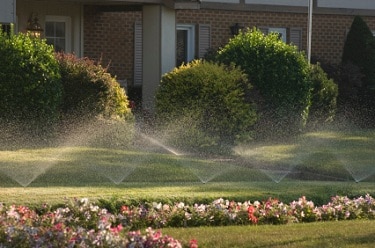Saving Money with Energy-Efficient Landscaping, Part 1: Shading
 If you’re a homeowner who’s thinking about having some landscaping done, there are several decisions you can make to both beautify your environment and help you reduce utility bill costs through energy efficiency gains for your home.
If you’re a homeowner who’s thinking about having some landscaping done, there are several decisions you can make to both beautify your environment and help you reduce utility bill costs through energy efficiency gains for your home.
For part one of our tips for energy-efficient landscaping, we’re taking a closer look at how incorporating shading techniques can lower temperatures in and around your home so you can start saving money on cooling costs. Make sure to check out part two, where we explore landscaping techniques that block wind chill and help you start saving money on heating costs.
Plants and Trees Lower Temperatures in Two Ways
Trees, bushes, shrubs, vines, and plants can help lower temperatures and decrease the workload for your air conditioning unit in two ways:
– Shade Blocking sunlight from your roof and walls is the most direct way to reduce solar heat gain in your home and lower your cooling costs.
– Evapotranspiration This is the process by which a plant moves and releases water vapor. A tree’s evapotranspiration can lower surrounding air temperatures up to 9 degrees. And because cool air settles near the ground, temperatures directly under trees can be as much as 25 degrees cooler.
Shading Your Home
There are four things you need to know when it comes to shading your home, including your regional climate, shading requirements, location of trees, and type of trees.
1. Regional Climate
The first thing you need to know about incorporating shading techniques into your landscaping is whether your regional climate means you’re better off with or without shading:
– Homes in warm climates that get a lot of solar heat in the summer typically benefit from a direct shading of roofs and walls.
– Homes in cool climates may actually suffer from too much shading, especially if protecting your home from solar heat gain in the summer is offset by additional heating costs incurred in the winter because roofs and walls don’t get not enough solar heat gain is reaching roofs and walls.
2. Shading Requirements
The next thing you need to determine is the size and shape of the moving shadow that you want your tree or trees to cast:
– To block solar heat in the summer use deciduous trees; they’ll let more solar heat in during the winter when you want it.
– To provide continuous shade year round use dense evergreen trees and shrubs.
3. Location of Trees
Determining where to plant your trees is critical in order to maximize shading benefits:
– For summertime roof shading plant deciduous trees with high, spreading crowns (leaves and branches) to the south of your home.
– For shading lower afternoon sun angles, plant trees with crowns lower to the ground to the west of your home.
– Make sure to shade your air conditioner unit to increase its efficiency by an additional 10 percent.
– In the case of solar-heated homes in cold climates, don’t plant trees on the southern side of your home, because the branches will block some winter sun.
4. Types of Trees: Slow Growth or Fast Growth
Generally speaking, slow-growing trees will give you greater benefit for longer than fast-growing trees:
– Although slow-growing trees will take years longer to get big enough to shade your roof, once they get to the right size they’ll live a lot longer.
– Slow-growing trees usually have deeper roots and stronger branches, which makes them less prone to breakage from severs storms or snow loads.
– Slow-growing trees are more drought-resistant.
A 6-foot to an 8-foot deciduous tree planted near your home will be able to provide shade for windows during the first year and will be able to provide shade for the roof in 5 to 10 years.
Cooling the Area around Your Home
Shading the ground and pavement around your home reduces heat radiation and cools the surrounding air before it reaches your home’s walls and windows. That means less heat radiates inside to your living space and your air conditioning system won’t have to work as hard to keep you comfortable.
Trees, shrubs, and groundcover plants do a great job of shading the ground and pavement around your home. You can use a hedge to shade a sidewalk, a row of shrubs to shade a driveway, and a trellis with climbing vines to shade a patio.
A trellis with climbing vines can be used to shade an entire wall and will grow fast enough to do so during the first year. You can also use a trellis with climbing vines, or a planter box with trailing vines, to shade your home’s perimeter, thereby lowering the temperature of the shaded area.
Shrubs that are planted close to your home can also be a great idea for shading walls and windows. They’ll usually fill in pretty rapidly and will begin supplying adequate shade within a couple of years. Just make sure to keep dense foliage from growing immediately next to your home if wetness or continual humidity are problems because the foliage will help retain moisture and prevent that part of your home from drying.
Sources
Energy Savers website, Landscape Shading.



